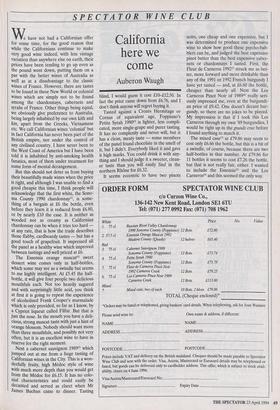SPECTATOR WINE CLUB
California here we come
Auberon Waugh
have not had a Californian offer for some time, for the good reason that while the Californians continue to make very good wine indeed, with less vintage variation than anywhere else on earth, their prices have been tending to go up even as the pound went down, putting them on a par with the better wines of Australia as well as at a disadvantage to the classic wines of France. However, there are tastes to be found in these New World or colonial wines which are simply not to be found among the chardonnays, cabernets and syrahs of France. Other things being equal, we obviously give preference to Australia, being largely inhabited by our own kith and kin, apart from the Greeks, Vietnamese etc. We call Californian wines 'colonial' but in fact California has never been part of the British empire, nor under the control of any civilised country. I have never been to the West Coast of America but I have been told it is inhabited by anti-smoking health fanatics, most of them under treatment for some form of mental derangement.
But this should not deter us from buying their beautifully made wines when the price is right, and although I was unable to find a good cheapie this time, I think people will acknowledge that the first white, the Sono- ma County 1990 chardonnay"), is some- thing of a bargain at £6 the bottle, even before they learn it is reduced from £6.80, or by nearly £10 the case. It is neither as wooded nor as creamy as Californian chardonnay can be when it tries too hard at any rate, that is how the trade describes those flabby, cardboardy tastes — but has a good touch of grapefruit. It impressed all the panel as a healthy wine which improved between tastings and well priced at £6.
The Essensia orange muscato sweet dessert wine comes only in half-bottles, which some may see as a swindle but seems to me highly intelligent. At £5.45 the half- bottle, it will give four people two delicious mouthfuls each. Not too heavily sugared and with surprisingly little acid, you think at first it is going to repeat the experience of alcoholised Frank Cooper's marmalade which is only provided, so far as I know, by a Cypriot liqueur called Filfar. But that is just the nose. In the mouth you have a deli- cious, strong muscat taste with just a hint of orange blossom. Nobody should want more than three mouthfuls, and possibly not very often, but it is an excellent wine to have in reserve for the right moment.
. Next a cabernet sauvignon 19890) which Jumped out at me from a huge tasting of Californian wines in the City. This is a won- derfully fruity, high Medoc style of wine with much more depth than you would get from the Medoc for £6.15. It has no colo- nial characteristics and could easily be decanted and served as claret when Mr James Buchan came to dinner. Tasting blind, I would guess it cost £10–£12.50. In fact the price came down from £6.76, and I don't think anyone will regret buying it.
Tasted against a Crozes Hermitage or Comas of equivalent age, Foppiano's Petite Syrah 1990t°> is lighter, less compli- cated, more single-grape and purer tasting. It has no complexity and never will, but it has a clean, meaty taste — some members of the panel found chocolate in the smell of it, but I didn't. Everybody liked it and gave it high marks. You could drink it with any- thing and I should judge it a sweeter, clean- er taste than you will easily find in the northern Rh6ne for £6.32.
It seems eccentric to have two pinots noirs, one cheap and one expensive, but I was determined to produce one expensive wine to show how good these psycho-bab- blers can be, and judged the best expensive pinot better than the best expensive caber- nets or chardonnays I tasted. First, the Fleur de Carneros 19920) struck me as bet- ter, more forward and more drinkable than any of the 1991 or 1992 French burgundy I have yet tasted — and, at £6.60 the bottle, cheaper than nearly all. Next the Los Carneros Pinot Noir of 19890) really seri- ously impressed me, even at the burgundi- an price of £9.42. One doesn't decant bur- gundy, so there are no jokes to be played. My impression is that if I took this Los Cameros through my own '89 burgundies, I would be right up in the grands crus before I found anything to match it.
The mixed casco at £79.86 may seem to cost only £6.66 the bottle, but this is a bit of a swindle, of course, because there are two half-bottles in that number. At £79.86 for 11 bottles it seems to cost £7.26 the bottle, but that is not really fair, either. I wanted to include the Essensia(2) and the Los Carneroso) and this seemed the only way.


























































 Previous page
Previous page